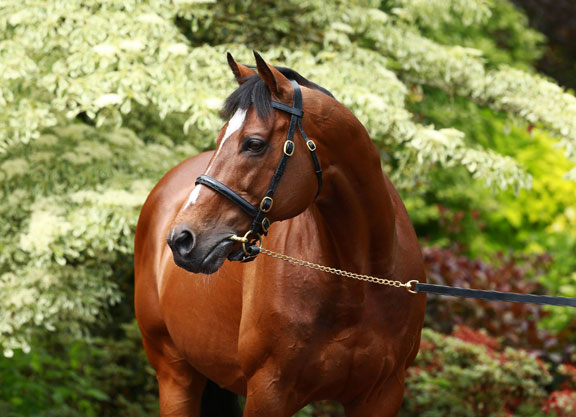By Chris McGrath
And still the arrow holds its course: that perfect blaze, tapered down from the fletching between his eyes until opening into the neatly pointed tip above his nostrils. His whole life has seemed to obey the inexorable momentum implied in that warpaint. Ever onwards, ever upwards. Sure enough, with perhaps the most telling of all his records secured outright by his daughter Peaceful (Ire) in the G1 Tattersalls Irish 1,000 Guineas on Saturday, Galileo (Ire) maintains his unwavering trajectory even into the evening of his career.
With another spring of undiminished virility behind him, at 22, Galileo could well elevate this latest benchmark–the 85th elite scorer of his stud career–beyond the reach of any future paragon. Even if pensioned tomorrow, Galileo would have four crops still to enter the fray; all, naturally, produced by mares of due eligibility. As such, even a century of Group 1 winners seems perfectly within his embrace.
The breed, then, can already count a relative longevity among the many Galileo assets to which it is indebted. Danehill, with whom he had previously shared the record, died in a paddock accident at 17. And Montjeu (Ire), the son of Sadler's Wells who contested the succession most ardently with Galileo, was lost through septicaemia complications at 16. Happily, their sire set a more hopeful example, having been retired from stud duty only at 27.
Those names, among very few of the modern era eligible for the same pantheon, all attest to the presiding genius behind Galileo. For Sadler's Wells, Danehill and Montjeu were three other bastions of the revolution in commercial breeding inspired by John Magnier and his partners at Coolmore.
Magnier's acumen as a breeder and dealer, of course, has been consecutively complemented by two other horsemen united by a comparable genius, the same surname, and the same stable. His father-in-law Vincent O'Brien was integral to the original transfusion of dynamic American blood into a stagnant European gene pool, most notably through Northern Dancer–sire and grandsire, respectively, of Sadler's Wells and Danehill. In Ballydoyle's modern epoch, of course, Peaceful's trainer Aidan O'Brien has proved no less relentless an achiever.
Posterity, in absorbing the impact on the Stud Book of Sadler's Wells and then Galileo, will have a convenient brand for the respective O'Brien eras. On the track, admittedly, Sadler's Wells did not seem to belong to the very first echelon of Ballydoyle champions. Indeed, Jim Bolger remembers getting into the lift at The Curragh after the horse had just won the Irish 2,000 Guineas, finding Vincent O'Brien there, and detecting a hint of bemusement in response to his congratulations.
And it was Bolger himself, of course, who later played a pivotal role in the Galileo story. Quite apart from his contribution as mentor to Aidan O'Brien, Bolger famously bet the bank on Galileo even as the early vibes were so discouraging that his opening fee of €60,000 had been cut to €37,500. When duly coming up with Teofilo (Ire) and New Approach (Ire), moreover, Bolger also sold access to Coolmore's most precious bloodline to the farm's habitual antagonists in Dubai. And that, in turn, has opened new branches of the Galileo dynasty–as in the case of 2018 Derby winner Masar (Ire) (New Approach {Ire}).
In fact, we have reached the point where lines through Galileo, Montjeu and Galileo's half-brother Sea The Stars (Ire) (Cape Cross {Ire}) have almost saturated the Classic endeavours of elite European operations. Certainly it has become incumbent on Coolmore, with so many of Galileo's daughters in their paddocks, to renew precisely the kind of overseas experiments that produced Sadler's Wells and company in the first place. Their search for a viable outcross has, once again, brought benefits for many others in Europe. War Front and Scat Daddy duly made their names as international influences, much like Storm Cat before them; and the early signs are that American Pharoah will transfer his ability to carry dirt speed onto grass.
Others, equally, have been able to share the formula evolved by Coolmore to sharpen Galileo's genetic preponderance towards stamina. With faster and faster mates, Galileo has increasingly broadened his repertoire to the extent that contributors to this new record include many juveniles, milers and even a Group 1 winner at six furlongs in Clemmie (Ire). In demanding ground, moreover, his son Gustav Klimt (Ire) came within a length of landing an elite sprint for older horses when third in the G1 Haydock Sprint Cup in 2018.
The ultimate dividend from sprinting mares, however, has obviously been Frankel (GB)–whose own spectacular start at stud suggests that Coolmore, having kept the premier heir to Sadler's Wells inside the corral, may not have managed to repeat that trick. Frankel, of course, is out of a Danehill mare and Juddmonte, to be fair, probably felt that his advent represented a courteous reciprocation after the sale of his damsire, at the end of his racing career, to stand at Coolmore.
This is not the place to debate the substance or otherwise of “crossing” sire-lines. It goes without saying that the Danehill mares sent to Galileo could only have been talented and/or well-bred, and the input of another great stallion should pretty reliably produce plenty of good runners as a result. Whether or not any specific affinity should be implied, it is not hard to accept that a little bit of Danzig pep could logically bring useful equilibrium to the staying power associated with Sadler's Wells.
Regardless, as things stand 15 of Galileo's 85 Group 1/Grade I scorers are out of daughters of Danehill. Of the dozen best on official ratings, however, only Frankel represents this supposedly alchemical formula.
There are, of course, manifold other genetic strands entwined in every pedigree. When Magnier bought him, for instance, the appeal of Danehill himself was doubtless heightened by the replication of Natalma on both sides of his pedigree: as third dam, and also as the mother of Danzig's sire Northern Dancer.
As one of the few mares in the breed's history to stand comparison with Natalma, Galileo's dam Urban Sea (Miswaki) must also be staunchly defended against any clumsy inference that he inherited the Sadler's Wells dominions simply by paternal succession.
For Urban Sea, not Galileo, is the true monarch of Epsom in the 21st Century, having divided her influence there through her other great son Sea The Stars (Ire); not to forget her great-granddaughter Khawlah (Ire), who is by the same sire as Sea The Stars and gave the family another Derby winner a couple of years ago in Masar.
Masar's luminous distinction, in being inbred 3×4 to Urban Sea, was predictably given less attention than the fact that he carries exactly the same imprint of Ahonoora (GB). By the same token, it surely behooves us to ask whether less familiar genetic strands behind Urban Sea may have contributed to her legacy. The German family is by now well familiar, decorated as it also is by the likes of King's Best (Kingmambo) and Tamayuz (GB) (Nayef); but even Bolger has professed perplexed curiosity as to the sire of Galileo's third dam, a forgotten grandson of Tesio's charismatic Donatello (Ity) named Espresso (GB).
Enough dredging the past; let's look ahead. Even the greatest empire has its frontiers. Are there still uncharted deserts Galileo can colonise?
Well, of course. Most obviously, his perennial multiple representation in the Derby makes Galileo highly eligible to claim outright the record of four winners he currently shares with Montjeu, as well as Blandford, Cyllene, Waxy and Sir Peter Teazle. And there is unfinished business, also, with his own sire. Sadler's Wells was champion sire of Britain and Ireland 14 times; Galileo has so far managed 11 titles. As we've already said, however, he has plenty of ammunition still to be unloaded.
It is the horse from whom he claimed this latest record, however, who perhaps makes Galileo look to his laurels. Danehill, in addition to his three domestic titles, was champion sire of Australia nine times; and the dynasties he founded there, as a shuttling pioneer, make him one of the breed's all-time game-changers.
Galileo, notoriously, made less of an impression after five sojourns in the Hunter Valley early in his stud career resulted in three locally-bred Group 1 winners, but a further six imports from the North have thus far brought his tally in Australasia to nine. Nor has he matched the diverse reach of El Prado (Ire), the principal conduit of their sire in America. Though El Prado and his son Kitten's Joy conform to the Sadler's Wells profile as unequivocal turf stallions, and Galileo ran that way when rolling the dice on dirt at the Breeders' Cup, Medaglia d'Oro has parlayed his inheritance onto dirt both as a runner and a sire; and the El Prado line has also diversified to produce sprinters as fast as Astern, Artie Schiller and Bobby's Kitten.
Frankel, it must be said, had a running style tailor made for dirt. Perhaps his own stock, who have shown a similar tendency to carry speed, may yet be given that chance. (His brother Noble Mission already has a top-class dirt runner in Code Of Honor.) As it is, however, the single deficiency in Galileo's historic career might be a failure to translate his breed-shaping influence beyond a known, congenial environment. He has not matched the geographical reach of Danehill, nor straddled disciplines like El Prado's sons.
But these are the imperfections sewn into the Persian carpet, against any presumption of divinity. Galileo has been an impeccable influence, giving a priceless glamour to attributes–stamina, constitution, courage and sheer Classic quality–that were falling perilously out of favour. What that would have meant, without him, is easy to see. Just look at the ostensible “commercial” sector in Europe: it is dominated by precocious sprinting blood, generally without the faintest pretension to breeding a Classic racehorse.
To that extent, Galileo and his clan have actually profited from an increasingly clear run, above all at Epsom, a target in effect renounced by any breeder favouring “commercial” types over stallions eligible to challenge the Derby/Oaks hegemony. The same is largely true even of the mile Classics, but Kitten's Joy has reminded us all–from severely limited opportunities in Europe–that there are alternatives to defeatism.
As it is, however, let's celebrate an emperor who remains gloriously in his pomp. For so long as people still breed Thoroughbreds, the legacy of Galileo will be honoured. And whatever else Peaceful goes on to achieve, her name will be preserved in the annals primarily for this latest seal on the prowess of her sire. For Galileo has redefined the very nature of the elite European racehorse–and immeasurably for the better.
Not a subscriber? Click here to sign up for the daily PDF or alerts.






